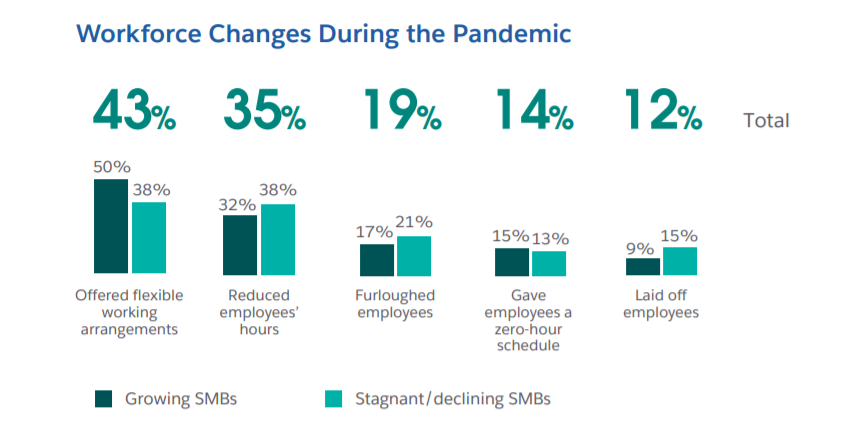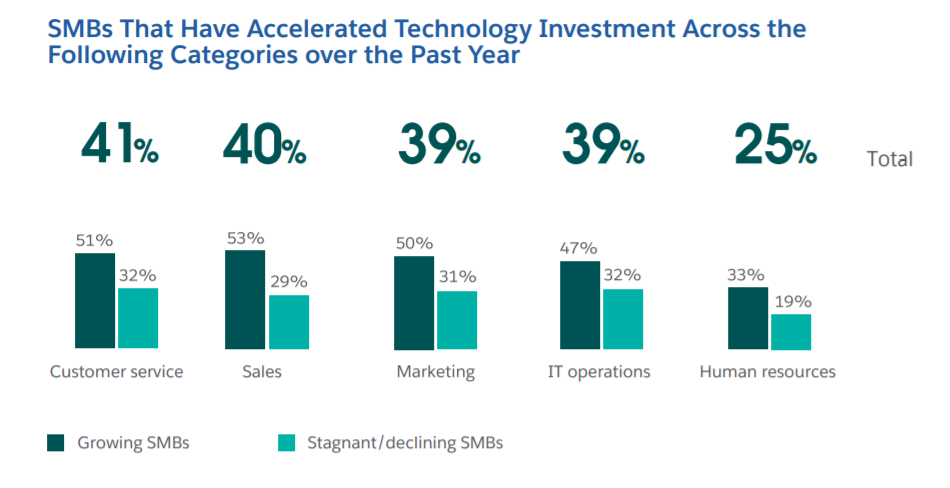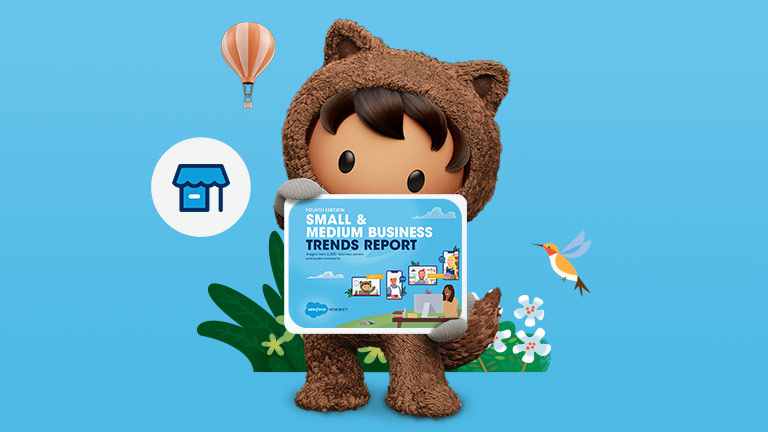The fifth edition of the Small and Medium Business Trends report reveals that small business employee benefits are becoming increasingly important in a post-pandemic world. And while the majority of SMEs held steady with their employee benefits during lockdown, others were forced to pare-back their offerings. Meanwhile, some growing SMEs increased their small business employee benefits in the face of covid.
According to the report:
19% of growing SMEs expanded their employee benefit offerings during the pandemic, vs only 7% of stagnant/declining SMEs.
32% of stagnant/declining SMEs had to reduce small business employee benefits, vs 26% of growing SMEs.
58% of SMEs made no change to their small business employee benefits.
As offices shut and businesses scrambled to keep remote employees engaged, small business employee benefits came under increased scrutiny. Now, the shift to remote and hybrid working has led many employees to seek out long-term flexibility. In fact, the Small and Medium Business Trends report reveals that having ‘flexible schedules’ is the top employee expectation. The ability to work remotely also cracks the top 5.
The competition for skilled, agile workers has only increased in the post-pandemic landscape, especially in the face of a global wave of resignations. Offering small business employee benefits, such as flexible schedules and remote working, not only helps to keep workers happy and engaged; it helps SMEs attract and retain talent.
How can offering small business employee benefits help SMEs?
One of the most important concerns for SMEs is improving productivity. Workers that are disengaged cost the global economy trillions of Euro each year in lost productivity. This is a critical issue in Europe, which has the least engaged employees in the world. To drive productivity, SMEs need to keep the workforce happy. And in order for employees to be happy, they need to feel appreciated. That’s where small business employee benefits come in.
Here are three ways that offering small business employee benefits can help SMEs.
Build the brand. Would-be employees used to have to hear about working conditions through the grapevine. Not anymore. Today, a workplace’s reputation is just a click away. There are entire sites dedicated to covering working conditions at companies. Offering good benefits will help to build a business’s reputation for being a place that people love to work.
Employee benefits can be business benefits. Many small business employee benefits empower the whole organisation, not just the team members. Offering access to on-demand training and digital upskilling programs equip workers with the tools they need to succeed. And while this helps drive employee engagement, it also helps SMEs avoid falling into the digital skills gap.
Reduce recruiting costs. Offering robust small business employee benefits will help SMEs increase employee retention. And SMEs save big by keeping workers. In fact, the cost of employee turnover can be crippling for SMEs, especially in a time of budget squeezes. When calculating the cost of small business employee benefits, don’t forget to make allowances for what it would cost to replace unhappy workers.
The importance of a satisfied workforce is clear. But what small business employee benefits should SMEs offer? And can SMEs afford to extend these benefits in an uncertain time?
How has the pandemic affected employee benefits for small businesses?
SMEs face a conundrum. They need to offer attractive benefits to recruit and retain talent. But limited resources mean that they may struggle to offer competitive benefits. And without the right talent, they’ll have trouble keeping up in the digital age. Rinse. Repeat.
Have a look at some numbers from the Trends report.
50% of growing SMEs offered flexible working arrangements during the pandemic. Only 38% of stagnant/declining SMEs did the same.
- 51% of growing SMEs increased their technology investment in customer service during the pandemic. Compare this to only 32% of stagnant/declining SMEs.
53% of growing SMES increased their technology investment in sales during the pandemic. Meanwhile, only 29% of stagnant/declining SMEs increased investment.
The numbers show that many growing SMEs were able to empower their employees with flexible working and new technologies to succeed in challenging times. Workers at stagnant/declining SMEs, meanwhile, were largely left to batten down the hatches. When it comes to employee satisfaction, whose employees do you think will be more engaged?
What benefits packages should SMEs offer their employees?
Small business employee benefits will vary from organisation to organisation. What benefits your SME might offer could depend on everything from its location and the industry it operates within to the demographics and interests of the workforce.
Some benefits might include:
More paid leave. Offering more annual leave is one of the most attractive benefits a business can offer. It can even be as simple as giving employees their birthday off.
Flexible working. SMEs that can’t offer flexible schedules and remote or hybrid working options will struggle to compete for talent with businesses that can.
Private health insurance. While it might be prohibitively expensive for some SMEs, offering private health insurance can be a differentiator when it comes to recruiting.
Wellness-related perks. Offering cycle-to-work schemes, bonuses for meeting monthly step targets, and virtual fitness classes show that SMEs care about workforce wellbeing.
Entertainment perks. Subscriptions for unlimited cinema tickets or annual passes to local attractions can help workers unwind and de-stress.
These are just some potential small business employee benefits. From offering free snacks and onsite game rooms to travel vouchers and home-working tools, today’s SMEs are powering up their benefits packages to drive employee engagement in the new normal.
The importance of employee engagement
It’s important to take stock of the moment when considering workforce benefits. We’re in a post-pandemic world. Employees are quitting their jobs in droves. Many are looking to create new paradigms, where a more equal work-life balance is prioritised. Companies are shifting to hybrid work. Others to remote work. The standard 40-hour workweek is vanishing, but no one quite knows what will replace it. Simply put, businesses are transforming.
In this type of climate, it’s easy for workers to become anxious. Creating small business employee benefits that prioritise their wellbeing and empower them to succeed is a good way to drive engagement. And while some SMEs may worry about costly benefits packages, it’s also crucial to account for the cost of lost productivity due to poor engagement. Even small steps can show employees that you care.
Offering attractive benefits is key for supporting the workforce. And an empowered workforce is key for supporting SMEs in the new normal, the next normal, and beyond.
To see more trends driving SMEs around the globe, check out the Small and Medium Business Trends Report.









